Day 2 in Cairo: the Pyramids, the Sphinx, camel rides, women’s rights discussion
March 2, 2025, Sunday
Our travel group at the Pyramids
Today's itinerary from Ayman:
06:00 - 08:00 Breakfast
08:00 departure from Gezira Lobby
PYRAMIDS & SPHINX
Wear closed shoes and hats, bring 2nd layer, and the whisper (radio to hear Ayman)
Extra excursions: Bring a credit card for a ticket to the interior of Cheops Pyramid (1500 EGP pounds) and bring $10 per person for camel rides
Lunch
04:00 Women's rights discussion
Drive to Giza
This morning, after breakfast, we met everyone at the bus by 8 o’clock, just as the itinerary requested. We knew where the Gezira lobby was; this time, I had left nothing behind. My credit card was in my purse for the tickets to the interior of the Cheops Pyramid, plus some cash for the camel ride. John carried the water bottle we shared. Ayman and the bus driver always had the bus stocked with water in plastic bottles. The hotels were stocked with plastic water bottles. Once again, I visited a country where the water was unsafe for tourists to drink. It makes me despair about the use of plastic in the world.
We took the 45-minute drive to Giza to see the Pyramids and the Sphinx. As we drove through Cairo’s busy streets, I thought, “So many buses, so many people.” During the drive, Ayman asked the group to guess what the population of Cairo was. All our guesses were too low. He told us there were 22 million people in Cairo. Wow. Google says that the population of Cairo proper is 10 million, and if you expand that to the surrounding towns like Giza, you get 22 million.
It makes sense that the population is spread along the Nile River in Egypt. Much of the territory is desert, which the Egyptian government is trying to reclaim by building dams and irrigating. Despite the dams and irrigation, much of the land is desert except along the Nile. One thing I noticed, and another person in the group commented on, was the sharp demarcation between the green of the irrigated land and the brown of the desert sand.
Pyramids
Photo of pyramids entry sign by Susan Corbin
We arrived at the crowded parking lot for the Pyramids, and the bus driver dropped us off at the entryway before he went to park that behemoth. Ayman handed out tickets as we exited. Below is a picture of all the tickets that Ayman gave us over the next 14 days for the various temples we visited during our tour.
Photo of tickets by Susan Corbin
I can’t say enough about how much I appreciated not having to keep track of all those tickets or stand in line to buy them. This is another reason I travel with O.A.T.
At the entry, ten of us bought extra tickets to enter the Cheops Pyramid. The two who did not were using canes, and they made the right choice. The first Pyramid we walked to was the Cheops Pyramid, where we spied the long line to go inside. Ayman wasn’t sure if we should go to the entrance to go inside or not since the line was so long.
He decided we should go ahead and get in line, and in retrospect, that was a good idea. The line didn’t get any shorter, and it seemed to be getting longer for a while.
Photo of us climbing up the pyramid in the line by Ayman
The entrance required climbing steps that had been chopped into the side of the Pyramid. Once at the entrance, you showed a guy your ticket, which he punched. Then, you proceeded into the open doorway behind the person in front of you. This trek was unlike anything I’d ever done in my life. I’m not sorry I did it and wouldn’t do it again. It was a one-time experience for me.
The tunnel was about 3 feet by 4 feet in most places. Going up at a 45-degree angle, hunched over at a 3-foot height for 139 feet (or so Ayman said), was a challenge. Most of the way in was back-to-front, with people traveling in both directions, going in and coming out. People coming down were red in the face and sweaty. Some complained of how hot it was in the burial chamber. The hardest part for me was a place where we could stand straight but climb at that angle. No one was in front of me, and I felt like I had to chug up that angle at top speed. Whew. I appreciated the small strips of wood nailed to the wooden walkway to give my feet traction.
Photos of tunnel by Eric
Finally, we arrived at the burial chamber. According to Google, it is 34 feet long, 17 feet wide, and 19 feet high, which is a reasonably large room empty, but it was filled with people. The people coming down and complaining of the temperature in the burial chamber were right. It was hot in there, and with the number of people constantly in there, the temperature stayed uncomfortably warm.
Photos of burial chamber from Ayman
We didn’t stay long. It was too hot and honestly, not that impressive. We saw more impressive carvings later in other temples. But we could say we went inside the Cheops Pyramid, so it was worth the climb. We turned to leave. As the people squeezed by going down, some went backward like a ladder, others frontward. I went down frontward, which made my glasses slip down my nose (sweat), so I finally took them off and put them in my pocket. I didn’t need to see anything except my feet anyway.
Our group stayed together as we entered, so we emerged together. We found Ayman and the two others in our party not far from the entrance, which also served as the exit. They bought scarves from the wandering vendors and generally enjoyed watching the people.
Camel riding
After we had joined with Ayman and the two who had not entered the pyramid, Ayman led us to the people offering camel rides. We were introduced to the men who gave the rides on the camels, and those who wanted to ride the camels were paired with a man and his camel.
I had read that camels have a rocking motion much different from the gait of horses because when camels walk, they step with their feet on one side and then the other. Horses walk with a hind foot on the left and a front foot on the right, giving them a much smoother gait. I had read that the gait of camels can cause motion sickness in someone more susceptible to that. I told John this because he is one of those motion-sickness-susceptible people. He declined to ride the camel. I thought that was a good idea because once you get motion sickness nauseated, it takes a laying down and often napping to get over it. We didn’t have time for that.
First, John and I got a picture with the camel. His name was Charlie.
Photo by Ayman of John and I with Charlie
Then, I was paired with a man and rode a camel with a man who led both my camel and Cindy’s. I gave the money collector the $10 bill I had brought.
Camels kneel when you get on them, so to stand up, they stand on their back legs first, then their front. We were told to lean way back as the camel got up so as not to fall off the front. That was a bit scary, but no one fell off. Whew.
Our group was led out a short distance to the desert. Ayman took pictures of us being led away.
Photo by Ayman of the group on camels
My guide looped my camel’s lead around a pommel on the back of the camel saddle in front of me, as he led them both. With Cindy’s phone, he took pictures of each of us leaning on the top of the pyramid. These guys knew exactly where to stand to get the best pictures.
Photo of me leaning on the pyramid by camel vendor
After photos, we were returned to those who chose not to go camel riding. My guide wanted backsheesh or a tip for the camel leading. Well, dang. All I brought was bathroom money. I didn’t have my purse with me. I told him I didn’t have anything more than that. He suggested I go back to the bus. I told him I was sorry, I wasn’t going to do that. I felt badly about it, but I brought what I was told to bring, and that was all I would do.
Sphinx
Next, Ayman walked us over to the Sphinx. He told us that archeologists conjectured that the Sphinx's head had been re-sculpted over the years because, if you look at it from above, the head is not proportional to the rest of the body.
Photo of Sphinx from above
You can’t get really close to it because it is behind a wall and a gate. I suspect they don’t want dumb tourists climbing on it, but you know they would. I walked along the wall and took this photo.
Selfie of me and the Sphinx
Lunch
After an amazing and enlightening morning, we went to lunch at an empty, and lovely restaurant. Many of the restaurants we frequented were empty, especially at lunch, because we were there during Ramadan, when many Muslims were fasting.
Photos of restaurant entrance by Susan
Lunch table by Susan
The restaurant was located in the area called New Cairo and New Giza. Later in the week, while on the boat, we saw a video about the construction of these new cities. There is some controversy about them because the government has built new government buildings there, but those who work in them can’t afford to live in the new apartments around them, which has led to long commutes. Yeah, I can see that being a problem.
After lunch, we got back on our bus and made our way to the hotel. We had a little rest time (I wrote, took a nap, or maybe both) and then gathered again in the Gezira lobby to attend the Women’s Rights in Egypt discussion at 4 p.m.
Egyptian Women’s Rights discussion
Ayman took us to the same room we had used for orientation on the first day. Before entering, he told us the young woman’s name was Yara. He said she enjoyed being acknowledged by name. It was sweet to hear everyone in our group say, as they walked into the room, some variation of “Hello, Yara.”
Yara told us she previously wrote for the Egyptian magazine What Women Want. Later in the day, Ayman forwarded links to some of the articles she had written for the magazine. She also told us that she was married with a two-year-old son. Her presentation included information about Sharia law on marriage vs. Egyptian law. They do vary. She told us that women in Egypt can choose whether to cover their heads in public or not, but what generally influences women on that choice is family, not law. She also talked about the plight of LGBTQIA people because not being heterosexual is outlawed. Unfortunately, some law enforcement officials were using gay dating sites to target people and arrest them. Overall, she was very well-informed and an engaging speaker. She answered everyone’s questions before she left us.
Rest time for an early departure
After the talk, we were free to have dinner on our own. I wasn’t hungry. We’d had a late, large lunch, so John and I returned to the room to rest, read, and write. I had brought some snacks that we had for dinner, and that was plenty of food.
We needed to get to bed early because we had an early flight to Luxor the next day. It was a 6 a.m. flight, so we had to meet the bus at 4 a.m. and have the bags out at 3:30 a.m. I was just beginning to get over jet lag. Oh, well, we set our phones for a 3 a.m. wake-up time to have time to shower.
The trip to Egypt, and Cairo specifically, did not disappoint me with what we saw. It was amazing to see the pyramids and the Sphinx personally. I was also impressed that they were so old and impressive. I’d seen them so often in photographs, but in person, they were just as grand as I expected.
Have you visited historical sights and been pleased or disappointed in your experience?

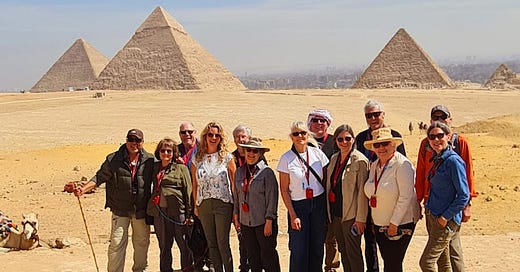



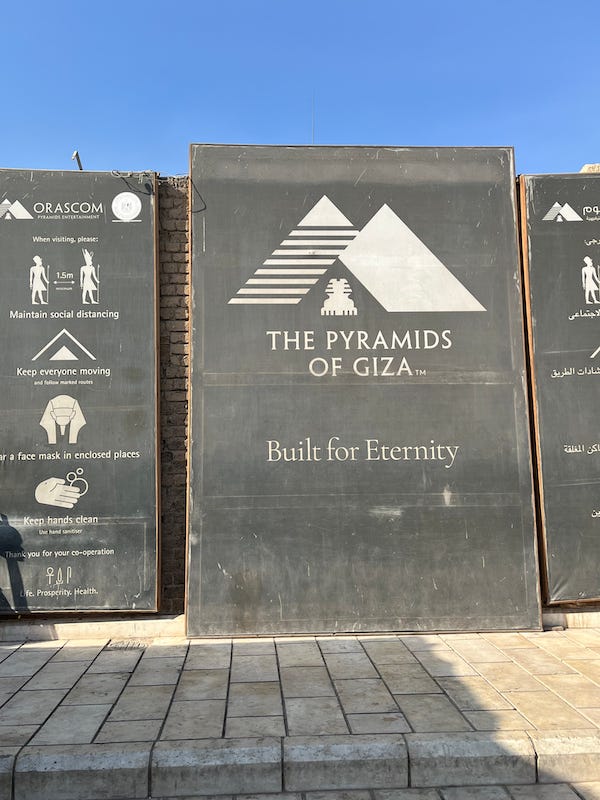
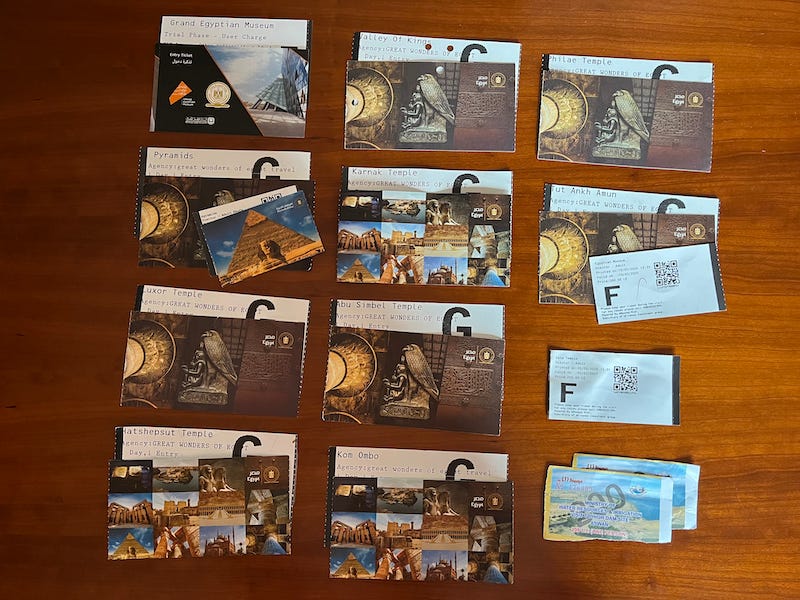
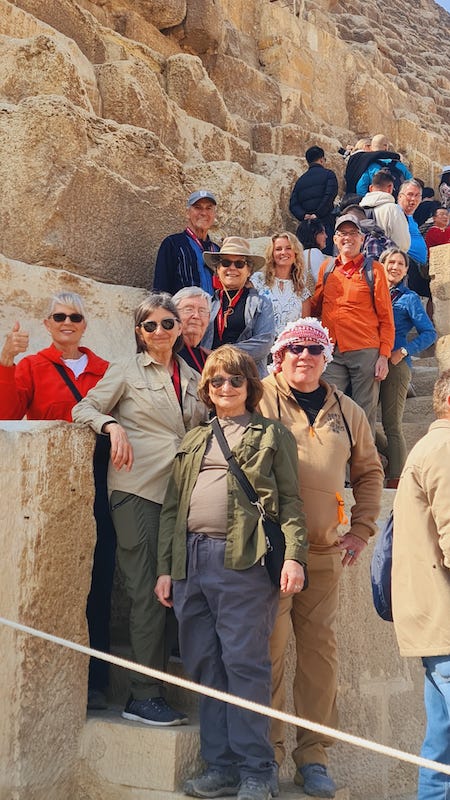


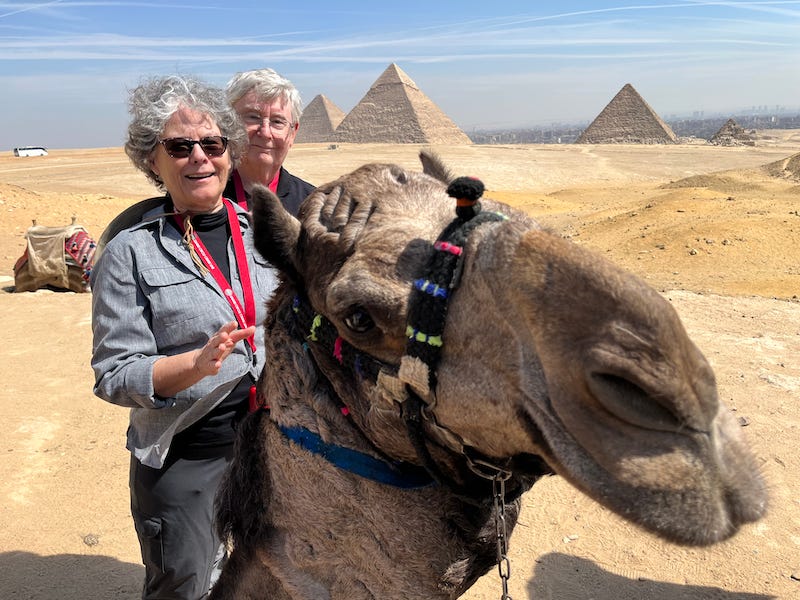



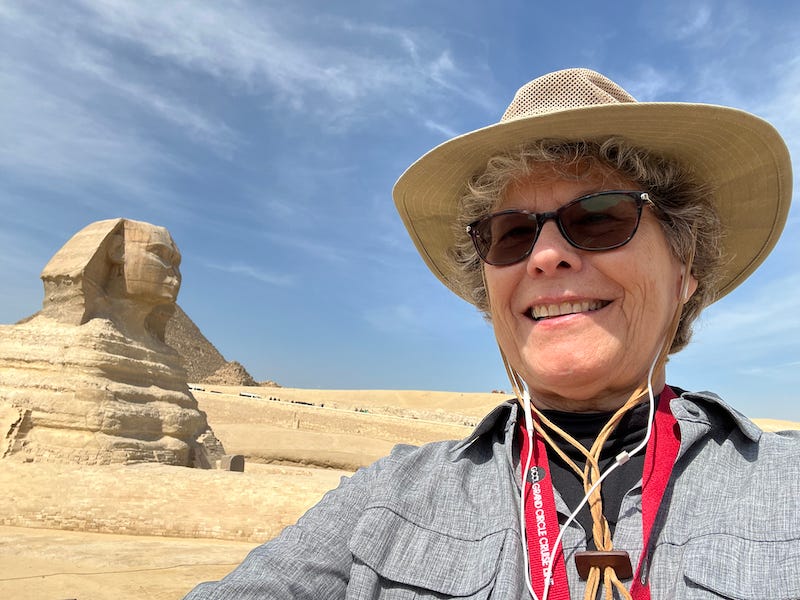

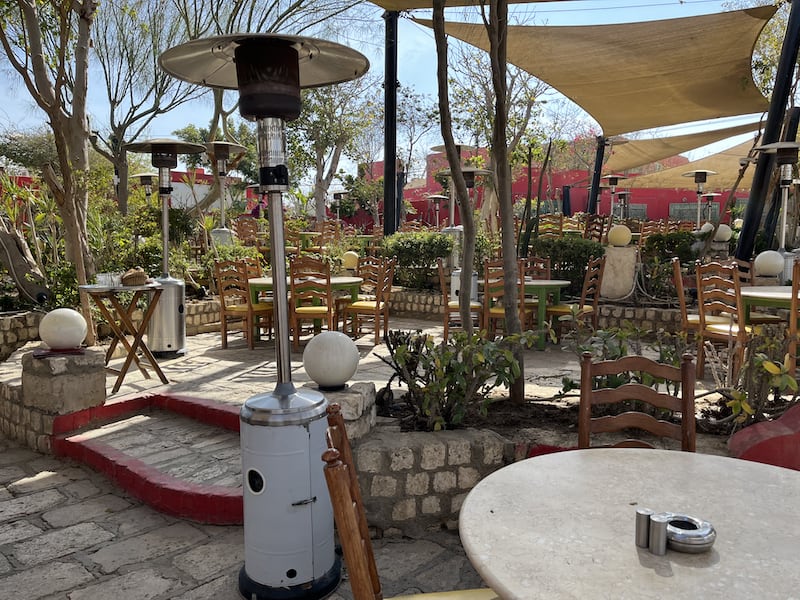

Egypt is a bucket list item for me! I've only seen the plundered bits in various museums. The British and French really helped themselves to giant busts and such that they could move. In Place de la Concorde in Paris, there is a description of how Napoleon had his men cart the Obelisk back. The British Museum in London has numerous artifacts and tons of mummies! Someday, I'll make it to the actual sites! Thanks for sharing!
Yes, the British and French took so many artifacts from Egypt. I have mixed feelings about this. The Egyptians had so many that they should have been able to spare a few, though they had no choice about what was taken. Also, seeing them in British and French museums may whet the viewers' appetites to visit Egypt to see them in situ. That seems like a good thing. I'm glad you are enjoying the posts.